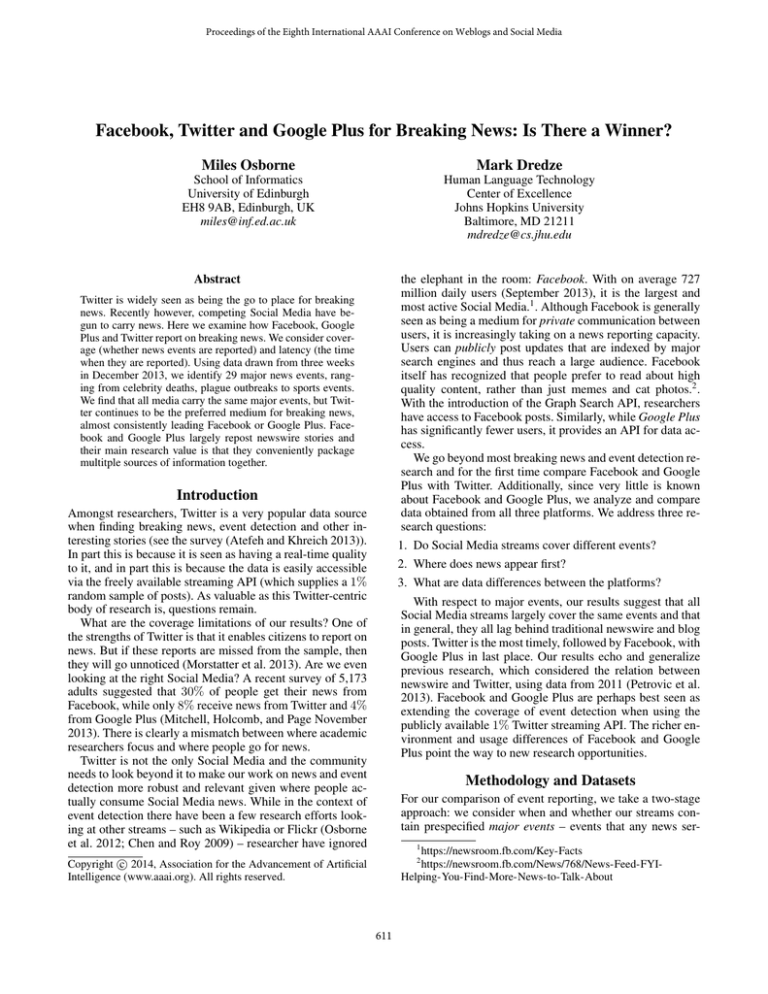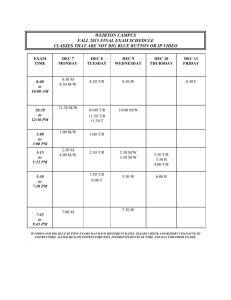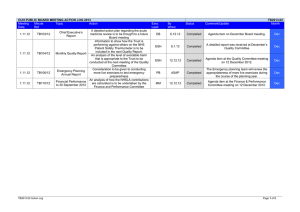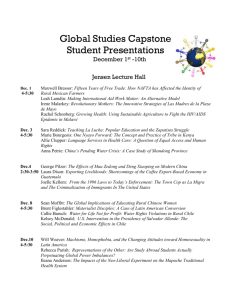
Proceedings of the Eighth International AAAI Conference on Weblogs and Social Media
Facebook, Twitter and Google Plus for Breaking News: Is There a Winner?
Miles Osborne
Mark Dredze
School of Informatics
University of Edinburgh
EH8 9AB, Edinburgh, UK
miles@inf.ed.ac.uk
Human Language Technology
Center of Excellence
Johns Hopkins University
Baltimore, MD 21211
mdredze@cs.jhu.edu
Abstract
the elephant in the room: Facebook. With on average 727
million daily users (September 2013), it is the largest and
most active Social Media.1 . Although Facebook is generally
seen as being a medium for private communication between
users, it is increasingly taking on a news reporting capacity.
Users can publicly post updates that are indexed by major
search engines and thus reach a large audience. Facebook
itself has recognized that people prefer to read about high
quality content, rather than just memes and cat photos.2 .
With the introduction of the Graph Search API, researchers
have access to Facebook posts. Similarly, while Google Plus
has significantly fewer users, it provides an API for data access.
We go beyond most breaking news and event detection research and for the first time compare Facebook and Google
Plus with Twitter. Additionally, since very little is known
about Facebook and Google Plus, we analyze and compare
data obtained from all three platforms. We address three research questions:
1. Do Social Media streams cover different events?
2. Where does news appear first?
3. What are data differences between the platforms?
With respect to major events, our results suggest that all
Social Media streams largely cover the same events and that
in general, they all lag behind traditional newswire and blog
posts. Twitter is the most timely, followed by Facebook, with
Google Plus in last place. Our results echo and generalize
previous research, which considered the relation between
newswire and Twitter, using data from 2011 (Petrovic et al.
2013). Facebook and Google Plus are perhaps best seen as
extending the coverage of event detection when using the
publicly available 1% Twitter streaming API. The richer environment and usage differences of Facebook and Google
Plus point the way to new research opportunities.
Twitter is widely seen as being the go to place for breaking
news. Recently however, competing Social Media have begun to carry news. Here we examine how Facebook, Google
Plus and Twitter report on breaking news. We consider coverage (whether news events are reported) and latency (the time
when they are reported). Using data drawn from three weeks
in December 2013, we identify 29 major news events, ranging from celebrity deaths, plague outbreaks to sports events.
We find that all media carry the same major events, but Twitter continues to be the preferred medium for breaking news,
almost consistently leading Facebook or Google Plus. Facebook and Google Plus largely repost newswire stories and
their main research value is that they conveniently package
multitple sources of information together.
Introduction
Amongst researchers, Twitter is a very popular data source
when finding breaking news, event detection and other interesting stories (see the survey (Atefeh and Khreich 2013)).
In part this is because it is seen as having a real-time quality
to it, and in part this is because the data is easily accessible
via the freely available streaming API (which supplies a 1%
random sample of posts). As valuable as this Twitter-centric
body of research is, questions remain.
What are the coverage limitations of our results? One of
the strengths of Twitter is that it enables citizens to report on
news. But if these reports are missed from the sample, then
they will go unnoticed (Morstatter et al. 2013). Are we even
looking at the right Social Media? A recent survey of 5,173
adults suggested that 30% of people get their news from
Facebook, while only 8% receive news from Twitter and 4%
from Google Plus (Mitchell, Holcomb, and Page November
2013). There is clearly a mismatch between where academic
researchers focus and where people go for news.
Twitter is not the only Social Media and the community
needs to look beyond it to make our work on news and event
detection more robust and relevant given where people actually consume Social Media news. While in the context of
event detection there have been a few research efforts looking at other streams – such as Wikipedia or Flickr (Osborne
et al. 2012; Chen and Roy 2009) – researcher have ignored
Methodology and Datasets
For our comparison of event reporting, we take a two-stage
approach: we consider when and whether our streams contain prespecified major events – events that any news ser1
https://newsroom.fb.com/Key-Facts
https://newsroom.fb.com/News/768/News-Feed-FYIHelping-You-Find-More-News-to-Talk-About
2
c 2014, Association for the Advancement of Artificial
Copyright Intelligence (www.aaai.org). All rights reserved.
611
vice should carry – and whether they contain long-tail events
– events that might not be carried by traditional newswire
and/or are not mentioned in our prespecified major event list.
Stream
Property
Value
Twitter
Major Events
Facebook
Source
Number of raw Tweets
Putative Events detected
Source
Number of raw posts
Putative Events detected
Twitter Streaming API
97 Million
3.3 Million
Graph Search
7.8 Million
228k
We use Wikipedia to identify 28 major events happening between 10th of December to 31st December 2013.3 These
events (Table 4) are not tied to any particular medium and
we would expect that any useful social stream would mention them. These events cover a broad range of categories,
including those often associated with Social Media (namely
natural disasters and celebrity deaths).
For each named event, we identified the first report in
each stream, noting the UTC time of the post. We used
Google (with the site: keyword) to manually search for
events in each stream since Google indexes all publicly
available posts, not just a sample. In some cases where we
had difficulty finding early mentions of an event, we utilized Bing search as well as the search engines provided by
Twitter, Facebook and Google Plus. For newswire, we used
both Google News as well as Google and Bing. For cases
when Social Media mentioned a newswire post that lacked
a timestamp, or when the newswire story had a timestamp
after the corresponding Tweet (presumably being an update
time), we assumed the newswire post had the same time as
the post (we found 5 such cases). Each event was investigated at least two times by two different people to ensure
we found the earliest post. We note Google often did not
index a specific post, instead indexing the timeline of the
user, which often did not contain a relevant post. This made
it challenging, particularly for Facebook posts, to find the
relevant earliest post. In some cases, we manually reviewed
dozens of posts from a single platform for a single event.
Table 1: Stream Statistics from December 10 to 31, 2013.
We treat the result as a randomly sampled stream.5 Note that
we know nothing about which posts Facebook returns and
cannot assume that the sample is in any way representative.
For our analysis comparing the benefits of each platform we
used a similar crawling strategy with the Google Plus API.
However, given our named event reporting results we focused solely on Twitter and Facebook for automated event
detection. See Table 1 for dataset summary statistics.
Do Social Media cover different events?
Previously work (Petrovic et al. 2013) established that Twitter and Newswire largely cover the same set of major events.
Is this true for (public posts in) Facebook and Google Plus?
Our major event results (Table 4) indicate that every event
appears on every Social Media platform. Drilling-down, we
noticed that the same content is often cross-posted. This
echoes the way that news content is syndicated in traditional
newswire; Social Media becomes just another publication
medium.
Turning now to the long-tailed events, we consider
whether Facebook contains events not mentioned in Twitter?6 Should those using Twitter data also consider Facebook
data, or does Twitter contain every Facebook event?
For both Twitter and Facebook, we used the same event
detection settings. Table 1 gives some statistics about the raw
and filtered event streams. While Twitter provides considerably more data, both streams yield similar relative amounts
of possible events (approximately 3%).
We then filtered the event streams using a classifier trained
on approximately 100k manually labeled events (interesting
vs. not interesting event) detected in Twitter over the Summer of 2011.7 Table 2 shows examples of content classification. This dramatically reduces the number of events, with
a risk of false positives and a possible bias towards stories
likely to appear in Twitter. The Twitter event stream reduces
from 3.3 million possible events down to 6053 events, whilst
the Facebook stream reduces from 228k down to 728 events.
For each Facebook event, we identified the closest matching
Twitter event. This attempts to pair corresponding stories.
Finally, we sampled 100 event-pairs for inspection.
Long-tailed Events
We considered additional events not in our Wikipedia list
by running a state-of-the-art event detection system over
data crawled over the same interval (Petrovic, Osborne, and
Lavrenko 2010). The system considers a post to be a newsworthy event if is appears new with respect to previously
seen posts (in that stream) and has at least one closely related
follow-up post appearing shortly afterwards in the same
stream. The first part finds novel stories and the second part
filters them, removing many false positives. This approach
favors recall over precision, returning many spurious events.
Twitter data came from the standard streaming API. Facebook does not (to our knowledge) supply a random sample
of posts, but it does provide a search API over public status
updates, yielding 400 updates per query.4 To create a random
sample status updates, we selected the top 1000 most frequent tokens from a month’s worth of Twitter data and continuously rotated between these tokens as queries to Facebook using a single crawler. This list included stop words in
multiple languages, as well as a few Twitter-specific terms.
5
Adaptive querying could obtain an unbiased sample from a
static document set (Bar-Yossef and Gurevich 2008), whereas we
have a dynamic set.
6
We would expect that event detection using Google Plus to
yield worse results, given that it has fewer users.
7
Interesting, or newsworthy, events include bombings, takeovers, celebrity deaths, etc.
3
http://en.wikipedia.org/wiki/December\ 2013
While the API allows requests for more results, we found that
larger requests often resulted in the API returning HTTP errors.
4
612
(a) Facebook
(b) Twitter
(c) Google Plus
Figure 1: Examples of first posts from each Social Media for the event “Jameis Winston wins Heisman trophy”. Twitter and
Facebook were from Citizen Journalists (users), whereas Google Plus is a story from an official news outlet.
Event
Iran, world powers to hold nuclear talks http
Stream
Mean Latency
# Scoops (SM only)
#BREAKING Tsunami Alert for Japan as second earthquake hits
coast of Japan at 7.9 Magnitude
Newswire
Twitter
FaceBook
Google Plus
0.54 (9.26)
2.36 (2.36)
9.89 (78.33)
14.01 (208.18)
22
9 (19)
2 (4)
0 (6)
Rupert Murdoch joins Twitter, immediately comes under fire
http: by @m4tt on @tnwtwit
Table 3: Mean (and stdev) reporting latency in hours (lower
is better). Scoops are the number of global first reports for
each stream (and Social Media only). Ties count for both;
higher is better.
All of your relationships could seem complicated these days an...
More for Virgo http:
@timeofy0urlife Are you interested in being your own boss?
Take control now and start making 4k a month in 3 months
1pm, Facebook at 2pm and Google Plus at 3pm, the latencies would be 0, 1, 2 and 3 hours respectively. The Latencies
show that Twitter reports news much faster than Facebook
or Google Plus, but still lags newswire. This latter point updates previous work on 2011 data (Petrovic et al. 2013). Additionally, Twitter has nearly all the “scoops” (first reported
post) of the Social Media, but much less than newswire.
Facebook broke the news first for the Miss World story (via
an account of a previous winner) and for a drug smuggling
story – involving an Irish national – by an Irish Radio station. Aside from those two stories, Twitter led Facebook in
every other case but two. Interestingly, Twitter did not always lead newswire for disasters. An event involving the
ceiling falling in a theatre broke via newswire, which posted
it soon after on Twitter.
In summary, to answer Question Two: Twitter is the best
for breaking news, but still trails newswire.
@shyB28 Want to be your own boss? I became mine 3 months ago and
now I make 4k a month working fro home
You were born because you’re going to be important to someone
Table 2: Example discovered events automatically classified
as content-carrying (in bold) or spurious.
17 / 100 pairs discussed the same event. For example, both
streams mentioned the Peter O’Toole death, the Target credit
card data loss and the academic strike in Nigeria. This shows
that the Facebook crawl does contain useful information.
Looking in detail at 20 Facebook stories that did not have a
corresponding matching Twitter story, we found that 13 had
matching Twitter stories when considering the full Twitter
firehose (searching Twitter.com), while two posts discussed
stories not in Twitter: Taiwan grounding helicopters and an
opinion piece about Russia. This shows that the Facebook
crawl extends coverage of the Twitter crawl and to a lesser
extent shows that there are stories in Facebook not reported
in Twitter. The remaining stories were false positives.
In summary, to answer Question One: it appears that all
Social Media sites cover the same major news events and
probably largely cover the same long tail of events.
What are data differences between platforms?
While all platforms provide similar news coverage, there are
clear differences in the type of content. Table 4 compares
properties of each platform. Even with a 1% cap, the Twitter
streaming API provides more data. Facebook and Google
Plus provide much richer posts, both in terms of length –
Facebook posts are roughly 10 times as long as tweets, and
Google Plus 5 times as long – and structured content, i.e.
long chains of comments. While Twitter has a conversation
feature, the 1% API is unlikely to supply all Tweets in a conversation, whereas Facebook and Google Plus posts include
associated comments.
We observe several interesting differences in the posts. A
huge number of Google Plus posts (44.2%) contain links,
Where does news appear first?
Twitter has a reputation for being the first place to report
on certain kinds of events, such as Earthquakes or Sports
events. Out of the three Social Media, it consistently carries
news before either Facebook or Google Plus. This is shown
in Table 3, which measured the average (and stdev) relative lag: the time between first post overall and the stream’s
first post. If Newswire carried a story at noon, Twitter at
613
Event
Newswire
Twitter
Facebook
Google Plus
Uruguay legalizes cannabis
Pope person of year
Bubonic plague outbreak
Golden Globe nominations named
Jang Sung-taek executed
Google removes privacy feature
Car bomb in Mali
Peter O’Toole dies
Chinese on moon
Jameis Winston wins Heisman
Jane Fontaine dies
Google buys Boston Dynamics
Michelle Bachelet elected
RnR Hall of Fame inductions
Santiago wins Miss World
Two sentenced for drug smuggling
Angela Merkel reelected
Australia wins Ashes
Gonzalo Inzunza Inzunza killed
Pussy Riot given amnesty
Ronnie Biggs dies
Target credit cards compromised
Apollo Theatre ceiling collapses
Canada overturns prostitution laws
Alan Turing pardoned
Shinzo Abe visits Yasukuni shrine
Joaquin Guzman heart attack
MS King Seaways catches fire
23:49 Dec 10
11:50 Dec 11
17:24 Dec 10
13:18 Dec 12
18:20 Dec 12
09:25 Dec 12
09:48 Dec 14
17:17 Dec 15
13:38 Dec 14
02:01 Dec 15
00:42 Dec 16
06:27 Dec 14
22:09 Dec 15
04:25 Dec 17
12:55 Dec 17
16:00 Dec 17
14:03 Dec 17
05:45 Dec 17
19:26 Dec 18
22:03 Dec 9
07:43 Dec 18
22:07 Dec 18
20:30 Dec 19
11:00 Dec 19
21:19 Dec 23
02:11 Dec 26
08:15 Dec 26
23:23 Dec 28
11:55 Dec 11
12:48 Dec 11
19:30 Dec 11
13:22 Dec 12
21:35 Dec 12
09:48 Dec 12
09:48 Dec 14
18:21 Dec 15
13:38 Dec 14
03:19 Dec 15
01:05 Dec 16
08:40 Dec 14
03:56 Dec 16
04:37 Dec 17
12:55 Dec 17
17:46 Dec 17
09:24 Dec 17
06:14 Dec 17
20:26 Dec 18
13:36 Dec 9
07:04 Dec 18
22:07 Dec 18
20:31 Dec 19
17:20 Dec 19
21:19 Dec 23
01:52 Dec 26
11:22 Dec 26
22:58 Dec 28
01:21 Dec 11
12:55 Dec 11
18:00 Dec 12
13:23 Dec 12
23:00 Dec 12
07:25 Dec 14
19:18 Dec 14
21:20 Dec 15
16:39 Dec 14
03:59 Dec 15
02:29 Dec 16
05:04 Dec 15
05:38 Dec 16
07:43 Dec 17
12:45 Dec 17
16:00 Dec 17
13:44 Dec 17
06:24 Dec 17
00:54 Dec 19
18:12 Dec 11
12:45 Dec 18
13:01 Dec 19
21:08 Dec 19
09:15 Dec 20
22:36 Dec 23
05:15 Dec 26
00:10 Dec 27
23:43 Dec 28
02:35 Dec 11
16:03 Dec 11
00:22 Dec 11
14:32 Dec 12
22:19 Dec 12
09:50 Dec 12
14:04 Dec 14
01:18 Dec 16
17:42 Dec 14
02:37 Dec 15
06:01 Dec 16
08:10 Dec 14
22:28 Dec 15
13:07 Dec 17
19:41 Dec 17
19:18 Dec 17
07:21 Dec 18
06:05 Dec 17
00:36 Dec 20
12:43 Dec 18
10:33 Dec 18
22:39 Dec 18
09:40 Dec 20
07:38 Dec 20
23:24 Dec 23
03:22 Dec 26
17:41 Dec 28
06:27 Dec 29
Property
Twitter
Facebook
Google Plus
Obtaining Data
Crawling Method
Messages per day
Streaming
4.2m
Search
2.3m
Search
180k
68/61/40
721/206/2105
433/206/950
Messages
Mean/Med./STD
length (chars)
Mean/Med./STD
length (toks)
Contains link
Contains hashtag
Contains username
Contains image
Resharing post
Geolocated
Platform
Real Name Only
Feedback
Discussion
Posting Method
a
10/8/7
125/38/357
55/23/123
16.0%
22.7%
14.2%
55.8%
10.4%
27.4%
2.9%
0.5%
3.1%
21.3%
68.4%
1.0%
95.4%
(44.2% excluding albums)
0.04%
5.0%
58.2%
29.2%
0.6%
No
favorites
Retweetsa
iPhone (26.9%)
Android (19.8%)
Web (18.3%)
Yes
Likes
Comments
Android (15.3%)
iPhone (14.4%)
Mobile (12%)
Yes
+1
Comments
NA
Conversations are not available via the streaming API.
Table 4: a) UTC times of first posts. Bold: first post, italics: first Social Media. b) Properties of different Social Media (based
on two days worth of crawled messages).
increasing to 95.4% when including links to Google albums. Google Plus is primarily used to share external content, as opposed to Twitter and Facebook. Hashtags are almost exclusively the domain of Twitter (Facebook (0.5%)
and Google Plus (0.04%)).8 Twitter posts frequently contain
references to other users (55.8%), likely a side effect of the
way conversations are implemented. Over a quarter of Twitter and Google Plus posts are retweets/shares, while 68.4%
of Facebook posts are shares.9 Twitter has the highest geolocation rate (2.9%), three times that of Facebook (1.0%).
Others have greatly expanded Twitter geolocation using the
location field in user profile (Dredze et al. 2013), whereas
Facebook and Google Plus do not include this information.
Twitter does not have a real name requirement for users,
whereas Facebook and Google Plus do. This may have an
impact on spam, trust and author attribution. Both Facebook
and Google Plus have a concept of ”like”, which opens an
interesting research direction, looking at the relationship between public declarations and (for example) rumor detection, impact and message propagation.
In summary, to answer question three: each platform provides different features and is used differently, suggesting
future work on how users perceive and use each platform.
for breaking news. Despite Twitter’s dominance, we demonstrate that these other platforms offer interesting possibilities
for many interesting research directions.10
Acknowledgements MO acknowledges support from EPSRC/DSTL grant EP/L010690/1.
References
Atefeh, F., and Khreich, W. 2013. A Survey of Techniques for
Event Detection in Twitter. Computational Intelligence n/a–n/a.
Bar-Yossef, Z., and Gurevich, M. 2008. Random Sampling from a
Search Engine’s Index. Journal of the ACM (JACM) 55(5):24.
Chen, L., and Roy, A. 2009. Event Detection from Flickr Data
through Wavelet-based Spatial Analysis. In CIKM.
Dredze, M.; Paul, M. J.; Bergsma, S.; and Tran, H. 2013. Carmen:
A twitter geolocation system with applications to public health. In
HIAI.
Mitchell, A.; Holcomb, J.; and Page, D. November 2013. News
use across Social Media Platforms. Technical report, Pew Research
Center.
Morstatter, F.; Pfeffer, J.; Liu, H.; and Carley, K. M. 2013. Is the
Sample Good Enough? Comparing Data from Twitter’s Streaming
API with Twitter’s Firehose. In ICWSM, 400–408. AAAI.
Osborne, M.; Petrović, S.; McCreadie, R.; Macdonald, C.; and Ounis, I. 2012. Bieber no more: First Story Detection using Twitter
and Wikipedia. In Proceedings of the SIGIR workshop on TimeAware Information Access.
Petrovic, S.; Osborne, M.; McCreadie, R.; Macdonald, C.; Ounis,
I.; and Shrimpton, L. 2013. Can Twitter replace Newswire for
Breaking News? In ICWSM.
Petrovic, S.; Osborne, M.; and Lavrenko, V. 2010. Streaming first
story detection with application to Twitter. In NAACL ’10.
Conclusion
We presented the first results for breaking news in Facebook
and Google Plus. Our results show all public posts in Social
Media streams carry similar events to each other. Yet Twitter dominates other Social Media in providing timely news.
Still, Twitter lags newswire, which remains the best source
8
When viewed in a web browser, many Google Plus posts contain hashtags, but these are not available using the API. These may
be automatically inferred after the post is created.
9
Computing this number is difficult since Facebook shares do
not show up as separate posts. Instead, each post contains a number indicating how many times it was shared at the time of crawl.
Summing this number yields a sharing of 68.4%, and 1.1% of posts
are shared at least once.
10
More details, such as data from Table 4, can be found at:
http://goo.gl/6ZCec3.
614







